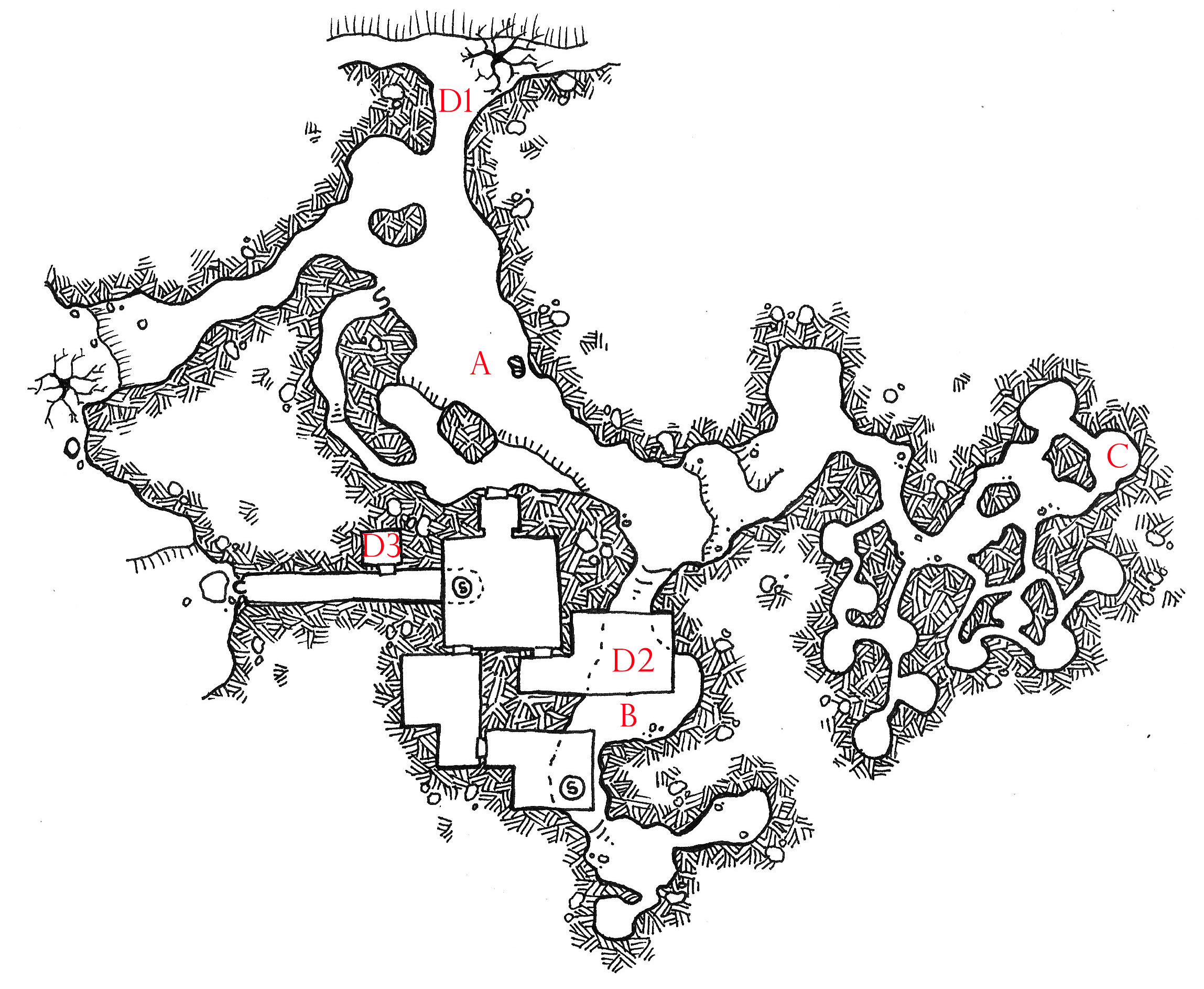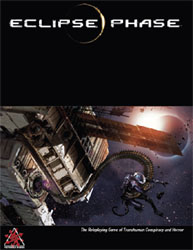Go to Part 1
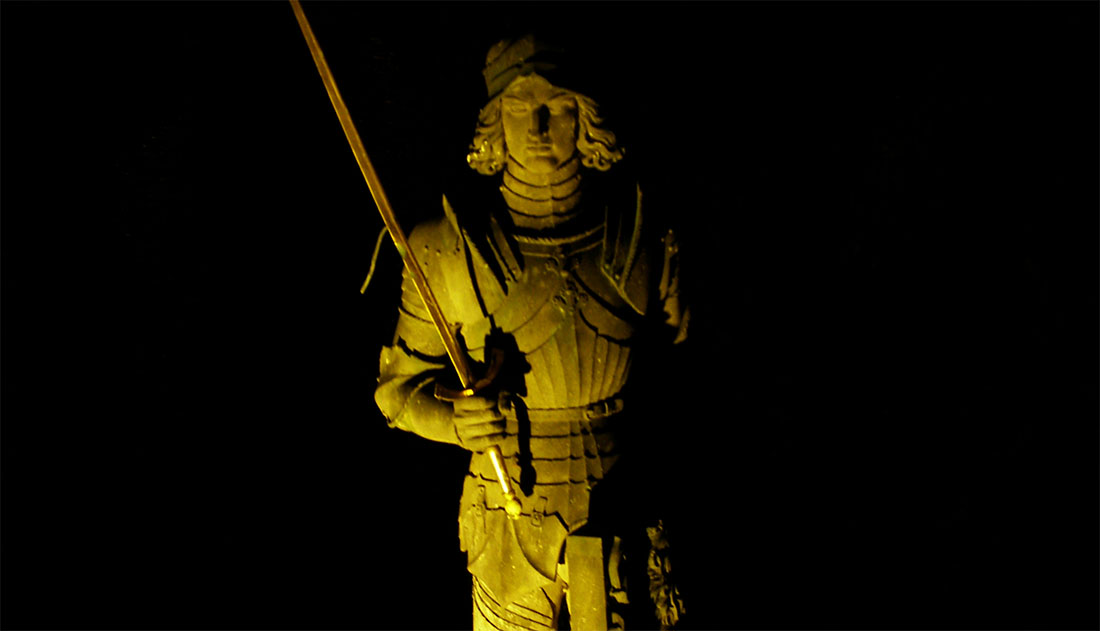
LABORATORY #22: COUNCIL CHAMBERS
A long, oval chamber with a circular bulge in the middle filled with a low, stone table surrounded by multi-hued floor cushions. In the center of the table is a large contraption of colored glass.
Around the perimeter of the chamber stand six stone statues depicting knights dressed in full plate and regalia. At one end of the chamber stands a seventh statue of a man in tattered crimson robes.
PERCEPTION (DC 16): The seventh statue is incredibly life-like and its cloths drift slightly in the slight breeze from the incoming teleport.
STONE GUARDIANS: The six stone statues are stone guardians who will attack anyone without the Sorcerous Brand of Arn.
SEVENTH STATUE: This man has been permanently paralyzed save for his eyes and brain. His mouth is frozen in a scream. After centuries in this state, he is quite insane.
KEY RECALL DEVICE: The glass contraption in the center of the chamber can be used to recall any extant keys for the teleportation network.
- Arcana (DC 20): To figure out that there are six concealed levers that must be depressed simultaneously. (However, these levers only work if depressed by someone with the Sorcerous Brand of Arn.)
- Arcana (DC 25): To conclude that there is a color-coded selector device. Three of the colors (black, purple, and yellow) have been smashed. Three others (red, green, and blue) have not.
- Arcana (DC 35): To discover an additional selection device coding for specific “etheric frequency”. Several such frequencies are attuned to each color. (These were unique codes which could be used to pull back a particular key, thus revoking someone’s access to the teleportal network. There’s no way to determine which code belongs to which person/key without the original code books, which are not present.)
- There are 2d4+1 of each color key type left in the world (including any possessed by the PCs). Determine randomly to see if the PCs pull back one of their own keys.
STONE GUARDIAN (CR 6): 60 hp (8d8+24), AC 19, slam +11/+11 (2d6+4), Save +9, Ability DC 16
Str 20, Dex 11, Con -, Int 10, Wis 6, Cha 11
Skills: Knowledge (Arcana) +11, Perception +8, Spellcraft +11
DR 10/adamantine
SR 18
LABORATORY #23: LABS OF THE ARBORETUM
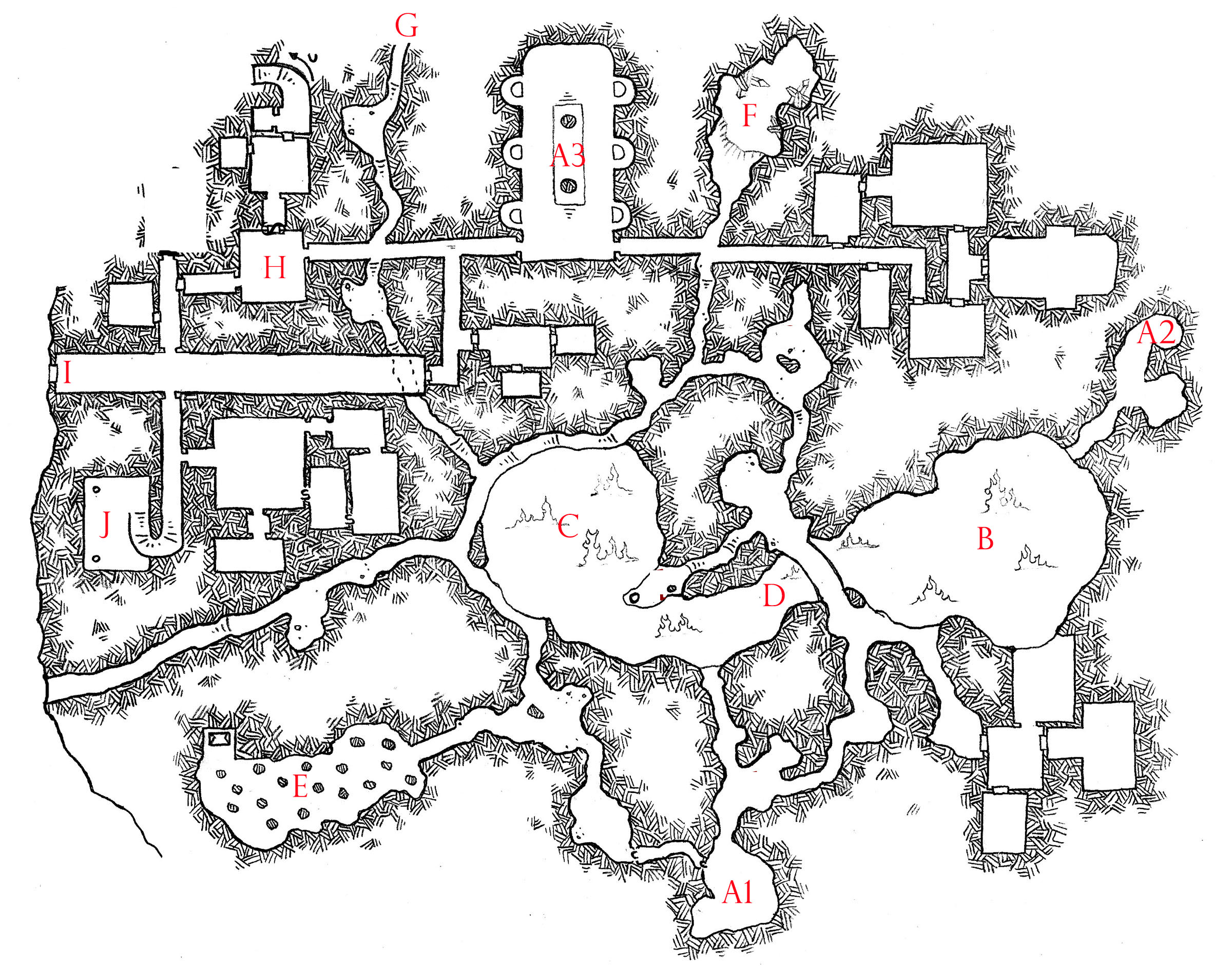
Map Courtesy of Dyson Logos
AREA A – TELEPORTALS:
- A1: Teleportal to/from area 21.
- A2: Teleportal to/from area 24.
- A3: Teleportal to/from area 22. And a black teleportal. (No key for the black teleportal is present in the current network. If it could somehow be activated, it would lead to a different network of laboratories not on the map.)
AREA B – FOREST CAVERN: A large, vaulted cavern filled with thick, green foliage.
- Husks(x3): Inhabit this cavern.
AREA C – FOREST CAVERN: A large, vaulted cavern filled with thick, green foliage. About half way up the wall of the cavern (50′ high up to 70′ or so) runs a curved ramp.
- Dormant Arboreoid: In the center of this area is the Dormant Arboreoid. It bears dozens of curious green-red fruits that do not spoil after being picked. If more than three fruits are plucked in a single day, however, the creature awakens. (Use roper stats.)
- Fruits: The fruits are bitter to the taste, but they immediately have the effect of a cure light wounds potion on the eater.
AREA D – UNDERPASS: This underpass is inhabited by four powerleeches (which will drop from above or rush out from small burrows to the sides). Powerleaches have the appearance of snakes, but their heads are surrounded by plates of hard, keratinous plates that are vaguely mollusc-like and gleam iridescently. As they leach energy, a small ball of lightning gathers between their fangs.
AREA E – CAVERN OF ASH TREES: This long cavern is filled with ash trees — literally trees which have been reduced to ash, but still stand in their underground grove.
- Improved Shadows (x8): Lurk amidst the trees.
- Ash Trees: Any disturbance of an ash tree will cause it to collapse, creating a 20′ radius cloud in which creatures within 5 feet gain concealment and creatures beyond 5 feet gain total concealment. (The ash does not block darkvision and the shadows can see just fine. A moderate wind (11+ mph) disperses the ash in 4 rounds; a strong wind (21+ mph) disperses the ash in 1 round.)
- Chest: Contains 10 crescent amethysts (each with a crystal imperfection at their heart) worth 500 gp each, a synaptic mask with a meld stone of the alchemist, and a set of crystal lenses set in golden rims (worth a total of 10,000 gp).
AREA F – CINDERSHARD CAVERN: This cavern contains a thick outcropping of cindershard, consisting of 100 crystals.
- Cindershard: A creature carrying a cindershard crystal (although not in an extradimensional space like a bag of holding) is immune to the harmful effects of sickstone. Once a cindershard is exposed to sickstone, it automatically “burns out” after 1d4 hours, turning into a powdery, non-glowing lump of stone. An intact cindershard is worth 25 gp. Cindershard powder is a mild curative (primarily useful as an ingredient in cure potions).
- GM Background: Cindershard often erupts in areas near sickstone; a sort of natural reaction to sickstone’s disruption of local balance.
AREA G – SICKSTONE CAVERN: Two hundred feet down this tunnel beyond the edge of the map is an outcropping of sickstone with alchemical equipment focusing its emanations up toward Areas F (in order to stimulate the growth of cindershard crystals there).
- Sickstone: Those within 30 feet of sickstone must make a Fortitude save (DC 12) or become sickened for 1 minute (10 rounds). This save must repeated once every minute. If engaging in strenuous activity (like combat), the save must be made every round. If a character who is already sickened fails a saving throw, they became nauseated for 1 minute (10 rounds). If a character who is already nauseated fails a saving throw, they suffer 1 point of Constitution damage (and continue to be nauseated).
AREA H – SECRET DOOR: This secret door leads to a staircase that leads up to a barrow mound in the distant lands of Hyrtan. Once outside, characters can teleport normally.
AREA I – ARCANE DOORS: 20′ high doors of copper and brass, engraved with strange runes, have been welded shut.
- Behind the Doors: If the doors are opened, they lead to a malfunctioning gate (corruscating cascades of purplish light which are painful to the eyes). Characters passing through the gate are returned to the same location 1d4 hours later after suffering torturous extradimensional exertions (inflicting 8d6 damage, Fortitude DC 19 for half damage).
AREA J – COPPER POLES: Two copper poles stuck into the floor, covered in verdigris.
HUSKS (CR 7): 75 hp (10d8+30), AC 20, slam +12/+12 (2d8+3), Save +10, Ability DC 17, Reach 15 ft.
Str 10, Dex 10, Con 12, Int -, Wis 10, Cha 6
Skills: Hide +13, Listen +13, Perception +13, Stealth +13
Exude Spider Swarm (Ex): One full action or when reduced to 30 hp, exude 6d6 spider swarms.
Lurching (Ex): Cannot run.
Spider Reach (Ex): The creature’s arms partially detach (remaining “connected” by an interlinked swarm of extending spiders), allowing them to slam nearby creatures within 15 ft.
Spider Grab (Ex): If both slams hit, start grapple as free action (spiders pouring out to suck the target in).
Spider Swallow (Ex): If it starts a turn grappling, a husk can attempt a grapple check to overwhelm a target in a mass of spiders. Swallowed creature suffers 3d6 damage per round from numerous spider bites. Victims can escape with two successful grapple checks. (Husk can reassert its grip at the start of its next turn if it is still grappling.)
POWERLEECHES (CR 6): 60 hp (8d8+24), AC 19, leechfangs +11/+11 (2d6+4 and leech), Save +9, Ability DC 16, Tiny
Str 8, Dex 16, Con 12, Int 10, Wis 6, Cha 11
Skills: Balance +15, Climb +10, Perception +7, Stealth +15, Swim +10
Burrow 30 ft.
Leech (Su): On a successful attack, spellcasters lose a random spell of the highest level they have prepared. Magical equipment loses one +1 or a random ability. (The leech is a temporary draining of magical potential and equipment abilities return at a rate of +1 or one ability every 24 hours.)
Leeching Rake (Su): If the powerleech strikes a single creature with both attacks, they deal an additional 2d6 damage to the target and leech an additional spell or ability.
Pounce (Ex): As a full action, a powerleech can move up to twice its speed and then perform a full attack.
SR 14
SHADOW, IMPROVED (CR 4) – CE Medium Undead (Incorporeal)
DETECTION – darkvision 60 ft., Listen +7, Spot +7; Init +2 (Dex)
DEFENSES – AC 13 (+2 Dex, +1 deflection), touch 13, flat-footed 11; hp 45 (7d12); Miss 50% (except incorporeal attacks); Immune incorporeal immunities (grapple, nonmagical attacks, trip), undead immunities (ability damage, ability drain, critical hits, cold, death effects, disease, energy drain, exhaustion, fatigue, mind-affecting, nonlethal damage, paralysis, poison, raise dead, sleep, stunning, and any effect requiring a Fortitude save (unless it also works on objects or is harmless))
ACTIONS – Spd fly 40 ft. (good); Melee incorporeal touch +5 (1d6 Str); Ranged +5; Space 5 ft.; Reach 5 ft.; Base Atk +3; Grapple -; SA create spawn, strength damage; Combat Feats Dodge, Flyby Attack
SQ darkvision 60 ft., incorporeal traits, turn resistance +2, undead traits
STR -, DEX 14, CON -, INT 6, WIS 12, CHA 14
FORT +1, REF +3, WILL +4
FEATS: Alertness, Dodge, Flyby Attack
SKILLS: Hide +11*, Listen +8, Search +5, Spot +8
Create Spawn (Su): Any humanoid reduced to Strength 0 by a shadow becomes a shadow under control its killer in 1d4 rounds.
Incorporeal Subtype: Immune to all nonmagical, corporeal attack forms. Even when hit by a magic weapon, spells, spell-like abilities, or supernatural abilty it has a 50% chance to ignore any damage from a corporeal source (except for positive energy, negative energy, force effects, or ghost touch weapons). Holy water can affect incorporeal creatures. Can enter or pass through solid objects, but must remain adjacent to its surface (enemies have total concealment while the shadow remains inside the object). Automatically succeeds on Move Silently checks. Invisible to nonvisual senses (scent, blindsight).
Incorporeal Attacks: Attacks ignore natural armor, armor, and shields.
Skills: +2 racial bonus on Listen and Spot checks. +4 racial bonus on Search checks. *+4 racial bonus on Hide checks in areas of shadowy illumination, -4 penalty to Hide checks in brightly lit areas.
SYNAPTIC MASK
A synaptic mask consists of several thin leather straps that affix to the wearer’s face. Most of the wearer’s face is visible through the leather webbing. The strands that make up the mask all come together at the wearer’s left temple, where a setting is affixed. The setting contains a clamp in which owners can set various types of special stones.
A synpatic mask uses up the same area on the body as a headband, hat, or helmet.
Synaptic masks have AC 5, 10 hp, hardness 3, Break DC 15.
Synaptic masks are always active while worn (they do not require activation). A synaptic mask confers an effect only when a shard or meld stone rests in its setting. Without a specified stone in its setting, the synaptic mask confers no extra abilities.
Manifester Level: 13th; Prerequisites: Craft Universal Item, fabricate; Market Price: 3,000 gp; Cost to Create: 1,500 gp and 120 XP; Weight: 1 lb.
Meld Stone of the Alchemist: When set in a synaptic mask, the meld stone of the alchemist grants its wearer a +8 competence bonus on their Alchemy checks, a +6 bonus on their Appraise and Use Magic Device checks, and a +4 competence bonus on their Knowledge (arcana) checks.
Manifester Level: 13th; Prerequisites: Craft Universal Item, fabricate; Market Price: 3,000 gp; Cost to Create: 1,500 gp and 120 XP; Weight: 1 lb.
Go to Part 8: Laboratories 24-26
Any material in this post not indicated as Product Identity in the Open Gaming License is released by Creative Common Attribution-Share Alike 3.0.
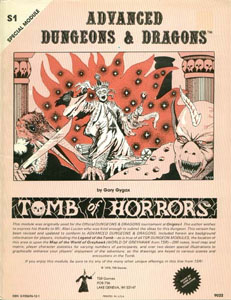 John Wick has written an article describing the Tomb of Horrors as the Worst Adventure of All Times. Personally, I disagree. Although back in 1999 I wrote a review of the Tomb which was critical of its many flaws and shortcomings (particularly by modern standards), even then I wrote that the module tantalized me “because it accomplishes exactly what it sets out to do”. My interest in the module eventually culminated in 2005 when I wrote a 3.5 adaptation which sought to make the module more usable by presenting it in a format easier for DMs to use (while also clearing up some of the design flaws). The result has been a really great one-shot scenario that has provided nearly a dozen different groups with some incredibly memorable experiences.
John Wick has written an article describing the Tomb of Horrors as the Worst Adventure of All Times. Personally, I disagree. Although back in 1999 I wrote a review of the Tomb which was critical of its many flaws and shortcomings (particularly by modern standards), even then I wrote that the module tantalized me “because it accomplishes exactly what it sets out to do”. My interest in the module eventually culminated in 2005 when I wrote a 3.5 adaptation which sought to make the module more usable by presenting it in a format easier for DMs to use (while also clearing up some of the design flaws). The result has been a really great one-shot scenario that has provided nearly a dozen different groups with some incredibly memorable experiences.
